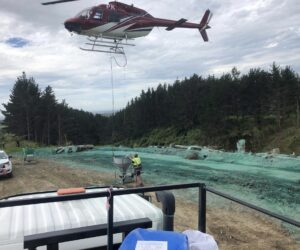The Challenge of Inaccessible Terrain
There are areas where conventional revegetation methods simply fail: steep alpine slopes, non-traversable scree fields, remote conservation zones, unstable post-fire hillsides, or protected ecosystems that prohibit the use of heavy equipment. In such cases, heli-seeding – the aerial application of seeds, mulch, and soil amendments via helicopter – is not just an alternative; it is the only feasible solution.
Technical Advantages of Aerial Revegetation
Heli-seeding enables precise, large-scale coverage of areas that would otherwise remain untreated. Using specially designed buckets or spray booms, the method allows:
-
Low-impact application with no surface disturbance
-
Access to remote or protected zones without road construction
-
Efficient coverage of hundreds of hectares within a short time window
-
Customized payloads for seeds, mulch, or biotic soil media
This makes it ideal for both emergency erosion control and long-term restoration.
Economic Viability: More Than Meets the Eye
Although aerial operations involve aircraft and pilots, heli-seeding can be economically sound—especially when considering:
-
Avoided costs for access roads, machinery transport, or restoration of damaged terrain
-
Minimal ground crew requirements
-
Speed of implementation, which is crucial in erosion-sensitive areas post-disturbance
-
Reduced need for rework, as sensitive areas are treated before major degradation occurs
In mountainous terrain, the cost per hectare for heli-seeding is often equal to or lower than the total cost of conventional revegetation involving ground logistics, compaction repair, and manual installation.
Environmental and Regulatory Compliance
Heli-seeding supports regulatory goals related to:
-
Habitat protection (no disturbance of sensitive flora/fauna)
-
Water quality (rapid soil cover and sediment control)
-
Carbon footprint reduction, due to minimized use of heavy machinery
-
Revegetation of Natura 2000 or UNESCO areas, where ground-based access is either prohibited or severely restricted
SRBT Modular Systems for Aerial Application
SRBT has developed a series of modular aerial revegetation systems under its Heli-Seeding division. These systems combine:
-
Site-specific seed blends for high-altitude or degraded soils
-
Custom-formulated hydromulch mixtures with optimized water-holding and bonding agents
-
Optional biotic soil media (BSM) for areas with poor topsoil
-
Pre-mixed loads for helicopter bucket or tank use, compatible with dry or liquid application techniques
All systems are supported by SRBT-certified partners and follow international restoration standards.
Conclusion
Heli-seeding is not an exotic luxury—it is a critical technology for areas where access, timing, and environmental protection converge. SRBT’s modular approach allows planners and engineers to respond quickly, effectively, and responsibly to some of the most demanding revegetation challenges in the world.

